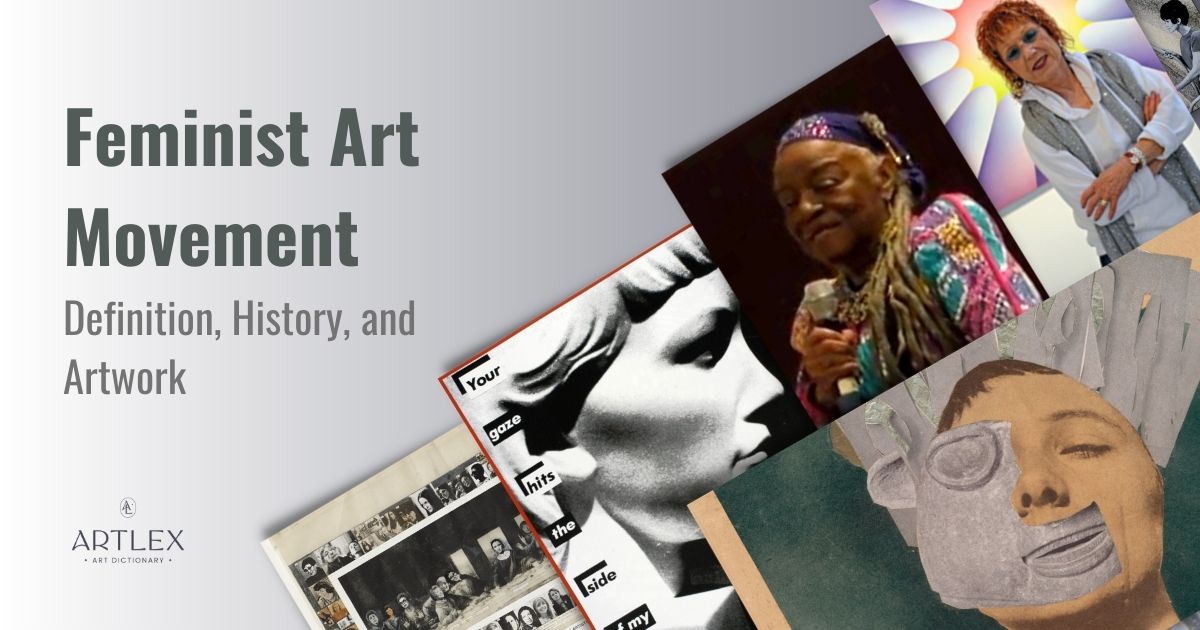
Feminist Art Movement
Feminist art represents a meeting point between feminism and art. While artworks focusing on the female experience in the world existed before the feminist art movement began, during the 1970s feminist art became defined and articulate. The feminist art movement also represents a field where activism and art flourished together. In the 1980s, the famous art critic Lucy R. Lippard said that feminist art should not be seen as either a style or a movement, but as a value system and a way of life.
Feminist art focused on the female experience in the modern world. That experience could be connected to patriarchy, housework, family, body image, motherhood, artworld, or any other topic related to women’s everyday life. It’s important to know that not all art created by feminists in art history is considered feminist art and not all art created by women artists is a part of the feminist art movement.
Feminist artists were inspired by different gender-related questions. These artists wanted to deconstruct gender and see what it meant to be a woman. Feminists often pointed at the performative aspects of one’s gender. Because of this feminist artworks sometimes showed women deliberately performing femininity.
Artists whose works belong to the feminist art movement include Judy Chicago, Miriam Schapiro, Faith Ringgold, Harmony Hammond, Faith Wilding, Nancy Spero, Elasnor Antin, Carolee Schneemann, Mary Beth Edelson, Sylvia Sleigh, May Stevens, Judith Bernstein, Betsy Damon, Suzanne Lacy, Hannah Wilke, Barbara Kruger, Cindy Sherman, Jenny Holzer, Joyce Wieland, and many others.
Feminist Art Movement Characteristics
Feminist art brought neglected art forms into the spotlight. Techniques like needlework, quilting, and ceramics were all given different kinds of attention by feminist artists. These art forms were historically regarded as inferior to painting and sculpture. To put it simply, these art mediums were negatively perceived as women’s work. Two feminist authors Griselda Pollock and Rozsika Parker wrote extensively about the division into spheres of high art and low art. The authors analyzed the crafts reputation as inferior because of the place of their origin, the domestic sphere, and their authors, who were mostly women.
Another characteristic of the feminist art movement was the frequent use of vaginal imagery, sometimes referred to as the Cunt Art. These types of artworks feature forms resembling the womb or the vulva. Some critics argued that this imagery would connect women artists to their biological identity only. However, feminist artists insisted on using vaginal imagery in their artworks wanting to change the negative perception of the female anatomy while making it more visible. Vaginal imagery is present in works created by one of the most famous feminist artists Judy Chicago. In her 1972 feminist artwork called Cock and Cunt a play was performed with the two main characters wearing big pieces of clothing resembling a penis and a vagina while a political text focusing on women’s roles in society was recited. Chicago frequently creates pieces inspired by female organs. For her famous installation The Dinner Party, Chicago came up with ceramic plates that resemble the female genitalia.
Menstrual blood, often considered taboo, is also featured in many feminist artworks. Within their piece called Womenhouse, Chicago and Miriam Schapiro created an installation called Menstruation Bathroom. The bathroom was filled with tampons, menstruation pads, and trashcans overflowing with used sanitary products covered in blood. Something that was previously hidden and kept private was now open for everyone to see. References to menstrual blood can be seen in an early feminist artworks made by the famous Canadian artist Joyce Wieland. In her 1961 piece titled Heart On Wieland used textiles covered in pink and red stains that could easily remind the viewer of menstrual blood.
Another characteristic of the feminist art movement is the use of goddess images. Goddess art was centered around the idea of goddesses as symbols of women’s spirituality and female power. In the United States, especially on the East Coast, Goddess images were influenced by Jungian archetypes. Goddess themes in art were also related to ecology and the planet Earth. Goddesses as a motif can be seen in feminist artworks made by Judy Chicago (in The Dinner Party), Mary Beth Edelson (in See for Yourself), Ursula Kavanagh (in Crete), Judy Baca (in Califia), Nancy Spero (in Goddess Nut II), and Jane Ellen Gilmore (in Eclecticism and Stress Series: The great Goddess at the Temple of Olympian Zeus).
Feminist Art Movement Concepts
Inspired by the social changes of the sixties, feminist art began as a movement that connected activism, social politics, and art. Feminist artworks touched upon themes related to patriarchy, gender roles, housework, racism, misogyny, racism, the beauty industry, and pop culture. There was an increase in the number of active women’s liberation groups during the sixties focusing on women’s issues that also influenced the social landscape where an art movement like feminist art could flourish.
Women became more aware of their position as objects in mass media, but feminist artists saw women as active and not passive. They no longer wanted to be portrayed as objects of the male gaze but as subjects of their own.
The women’s movement was greatly influenced by Betty Friedan’s book called The Feminine Mystique written in 1963. The book focused on the problem that has no name and the unhappy women who were stuck at home without a career of their own. The domestic sphere was starting to be seen as a place of confinement, anxiety, and depression. The problem Friedan wrote about can be noticed as a frequent theme in feminist art.
Books like Sexual Politics by Kate Millet (1970) and The Second Sex by Simone de Beauvoir (1949) were also very influential. Feminist education became important to many women artists. During the preparation phase of Judy Chicago’s installation The Dinner Party, volunteers were asked to read several books and publications on different gender-related topics. The goal was to raise consciousness and awareness about many issues that women faced.
Feminist Art Movement Trends
Feminist artists began using techniques and art forms that weren’t widely used by professional artists before them. Many women artists created textile-based artworks, making sure that techniques like embroidery or quilting were getting the recognition they deserved without being categorized as solely decorative and naive.
Feminist artists also created performance pieces, using the female body as a tool to convey their political messages. Some artists also turned to video art, which was a new and exciting art medium. Another important trend consisted of collaboration during the artistic process. Many feminist artists worked in groups and used the help of volunteers. The spirit of collaborative effort became crucial for the feminist art movement.
Feminist Art Movement History
There isn’t a precise year to which we can ascribe the start of the feminist art movement. The movement started around the late 1960s, however, there were many proto-feminist artworks made before that. The movement was at its peak during the 1970s and 1980s, heavily influenced by social changes and the political atmosphere of the period.
The spirit of the second wave of feminism forced the art world to begin to make steps toward equality in representation, such that female artists would get the same representation as their male counterparts.
The feminist art movement had its first big retrospective only recently, in 2008, at the exhibition titled WACK: Art and the Feminist Revolution at the Museum of Contemporary Art in Los Angeles.
- Origins and Historical Context:
- The movement emerged during the late 1960s, inspired by second-wave feminism and social changes in the 1960s and 1970s.
- Influential texts like The Feminine Mystique by Betty Friedan and Sexual Politics by Kate Millet inspired feminist consciousness in art.
- Early feminist art responded to the male-dominated art world and sought to challenge the male gaze in art, a concept popularized by Laura Mulvey in Visual Pleasure and Narrative Cinema (1975).
- Artistic Characteristics:
- Feminist art elevated neglected forms such as quilting, needlework, and ceramics, which were historically considered “women’s work.”
- Frequently used vaginal imagery (e.g., Judy Chicago’s The Dinner Party) to celebrate and redefine female anatomy, as well as menstrual imagery to challenge societal taboos.
- Goddess imagery symbolized women’s spirituality, ecology, and empowerment, as seen in works by Mary Beth Edelson and Judy Chicago.
- Pioneering Artists and Collaborations:
- Notable artists include Judy Chicago, Miriam Schapiro, Faith Ringgold, Cindy Sherman, and Barbara Kruger.
- Judy Chicago’s The Dinner Party and Martha Rosler’s Semiotics of the Kitchen became iconic works representing the movement’s ideas.
- Collaboration was a key principle, with feminist artists working together in groups or community settings (e.g., Womanhouse).
- Prominent Trends and Techniques:
- Performance art and video art were widely adopted, emphasizing the female body as a tool of political expression (Carolee Schneemann’s Interior Scroll).
- Text-based art and photomontages, such as Barbara Kruger’s works, challenged societal norms through bold graphics and text.
- Impact on Society and Art Institutions:
- Feminist art challenged museums to represent women equally, leading to protests like those by the Guerrilla Girls in the 1980s.
- It redefined art education with programs like the Feminist Art Program (FAP) founded by Judy Chicago and Miriam Schapiro at CalArts.
- Alternative exhibition spaces like the AIR Gallery and Soho 20 became platforms for women artists.
- Legacy and Influence:
- Feminist art influenced contemporary artists such as Tracey Emin and Sarah Lucas while sparking ongoing discussions on gender, race, and representation in art.
- It impacted related movements, including performance art, conceptual art, and postmodern art, and inspired art institutions to expand inclusion and diversity.
Feminist Art Movement in the 1960’s
During the 1960s the seeds needed for the feminist art movement to grow were showing. The increasing demand for changes in the art world inspired artists and activists to create works that would reflect their reality. They knew well that both art history and museums shouldn’t focus on male artists only. Women became more and more engaged with art theory and practice. During the 1960s, female artists like Evelyne Axell and Marisol Escobar created proto-feminist artworks showing female subjectivity and sexuality.
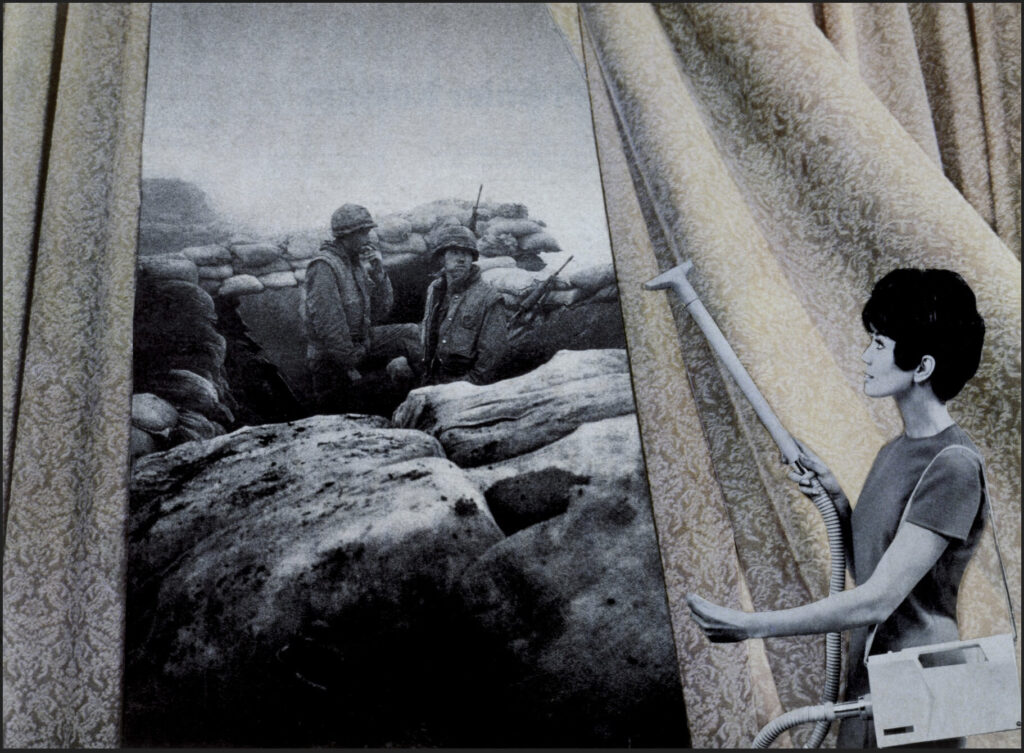
Feminist artist Martha Rosler started her famous series of photomontages called House Beautiful: Bringing the War Home in 1967. The series, created during the war in Vietnam, consisted of media images of American suburban housewives combined with war scenes.
In 1969, a feminist collective of activists and artists titled Women Artists in Revolution was formed.
Feminist Art Movement in the 1970’s
During the seventies, feminist artists problematized the objectification of women in media. Women artists turned to Hollywood movies, advertising images, and television shows for inspiration and often recreated the existing stereotypes in new subversive ways. In works like Audrey Flack’s Marilyn (Vanitas) we see a reference to the 1950s sex symbol Marilyn Monroe, who was often featured in works of Pop art. Feminist artist Cindy Sherman also frequently referenced American mass culture, finding inspiration in old Hollywood films. The female body took center stage in many works created by women artists during this time.
In 1972, Judy Chicago and Miriam Schapiro created a site installation called Womanhouse. Womanhouse became a collaborative art installation placed within an actual house in Los Angeles. The place was opened to the public only for a short while. Womanhouse was designed to reference a suburban home and a woman’s place in it.
The 1970s saw a rise in complaints regarding women’s place in the art community. In 1970, women protested at the Los Angeles County Museum of Art (LACMA) during an exhibition called Art and Technology which featured no women artists. After this protest, the Los Angeles Council of Women Artists was formed. In 1971, the Women in the Arts (WIA) organization was founded. The members of WIA focused on gender equality (and inequality) in representation in American museums. They sent out an open letter to major museums like MoMA and the Metropolitan Museum of Art asking for an increase in exhibited works created by women artists. Linda Nochlin published her influential essay titled Why Have There Been No Great Women Artists? in 1971 giving a feminist perspective to art history. A year later, The Feminist Art Journal was founded.
In 1970, Faith Ringgold and Michele Wallace founded Women, Students and Artists for Black Art Liberation organization. Ringgold became known for her activism focusing on the exclusion of Black artists from the American art world. Together with five other artists, Ringgold organized an exhibition featuring works made by twelve Black women artists at the Acts of Art Gallery in New York City. The same year, Judy Chicago started her first artistic feminist art program at Fresno State College. Chicago and Miriam Shapiro subsequently came up with the Feminist Art Program (FAP) at California Institute for the Arts. London Feminist Art History Collective, which focused on researching art created by women, was established in 1973.
During the 1970s, alternative places like Soho 20 galleries and AIR gallery made it possible for feminist artists to exhibit their works and organize their own exhibitions outside the mainstream institutions that wrongfully excluded them. The alternative ways of exhibiting, publishing, and communicating with the public made feminist art during this decade a more cohesive movement.
Feminist Art Movement in the 1980’s
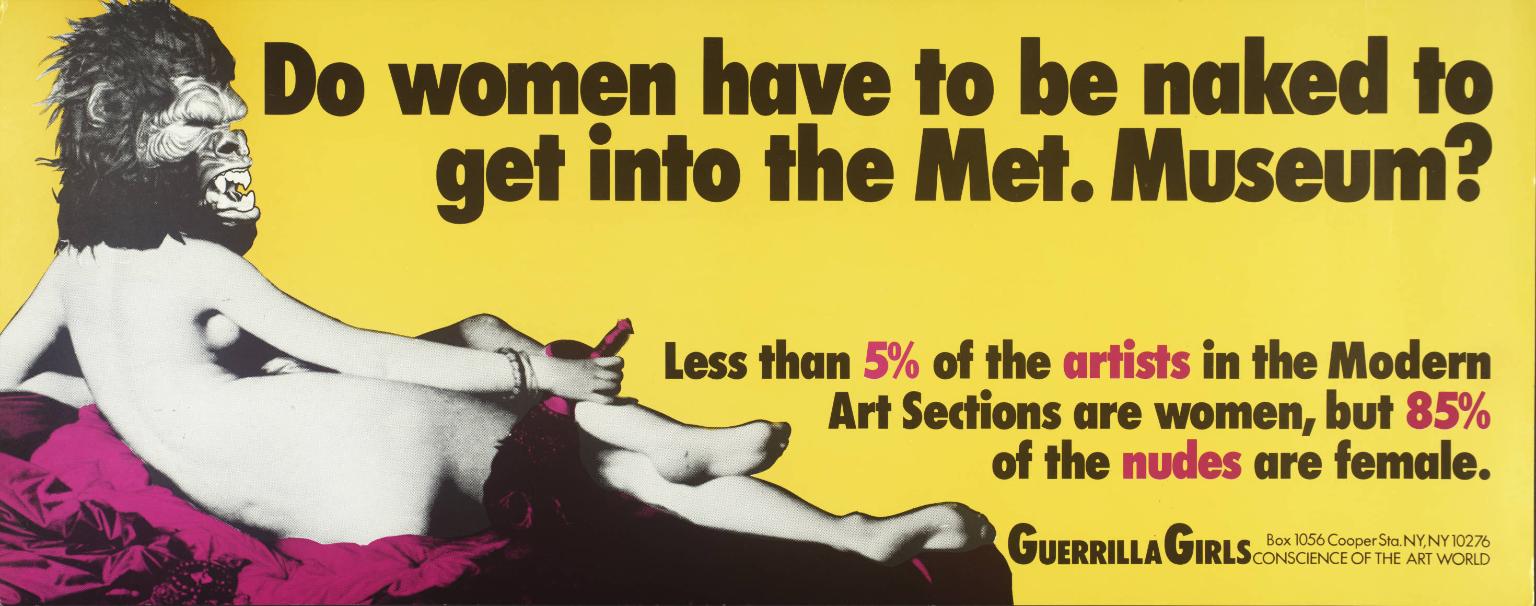
During the 1980s, the Guerrilla Girls made their famous artworks. They put posters on walls of the streets of New York City, inspired by the 1984 International Survey of Painting and Sculpture held at MoMA where less than 10 percent of works were created by women artists. In their 1989 work titled Do Women Have to Be Naked to Get into the Met Museum the Guerrilla Girls offered a reimagined version of Jean Auguste Dominique Ingres’ famous Odalisque from 1842, along with a text stating the statistics on exhibited women artists and female nudes at the Metropolitan Museum of Art.
The Women’s Art Journal was founded in 1980 and artists like Barbara Kruger and Jenny Holzer created their famous pieces focusing on different gender-related issues.
Contemporary Feminist Art
While feminist art doesn’t function as a cohesive art movement in the contemporary art world, we can still see the presence of its ideas and aims.
Feminist pieces influenced artists like Tracey Emin and Sarah Lucas. In Emin’s famous piece My Bed we see underwear stained with menstrual blood, a motif that was featured in numerous feminist works. Paula Rego’s 1998 Abortion series centers around ideas connected to women’s health and women’s reproductive rights that were also portrayed in many feminist pieces.
It’s important to note that many artworks inspired by feminist art created during the nineties show more awareness of differences between women themselves. These works focus more on particular experiences of marginalized groups within an already marginalized group.
Feminist Art Movement Artists
Prominent feminist art movement artists include Miriam Schapire, Carolee Schneemann, Faith Ringgold, Judy Chicago, and Cindy Sherman, among others. More information on these artists is included below:
Miriam Schapiro
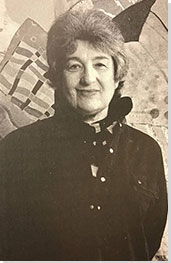
Miriam Schapiro is best known as one of the pioneers of feminist art. She was born in Toronto, Canada in 1923, but spent most of her life in the United States. She worked as an artist and an activist. In her works, Schapiro incorporated elements of artistic practices that were regarded as inferior to painting and sculpture. The artist called her collages mixed with fabrics femmages. She collaborated with another feminist artist, Judy Chicago. Schapiro died in New York in 2015.
Carolee Schneemann

Carolee Schneemann was a famous feminist performance artist. She was born in Pennsylvania in 1939 into a middle-class family. In her works, Schneemann used her body as a tool to create experimental video works and performance pieces where she acted as both the model and the artist. One of her best-known performance pieces called Interior Scroll saw the feminist artist paint her body with mud, read her book called Cezanne, She Was a Great Painter, and pull a paper scroll out of her vagina. Schneemann died in New York in 2019.
Faith Ringgold
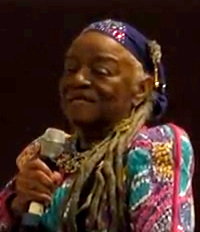
Faith Ringgold is a famous feminist artist and activist who was born in Harlem, New York City in 1930. Ringgold has had a prolific career during which she created paintings, performance pieces, and mixed media sculptures. Ringgold is particularly known for her fascinating quilts dealing with different feminist issues and social politics. Her works focus on topics related to race and gender inequality. Ringgold also works as a lecturer and a writer.
Judy Chicago
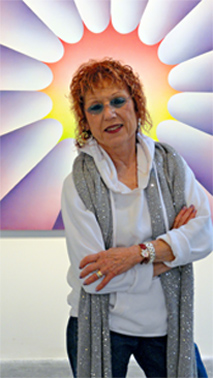
Judy Chicago was born in Chicago in 1939 as Judith Sylvia Cohen. Today, she is one of the best-known American feminist artists. Chicago has made feminist paintings, sculptures, performances, art installations, and even handbags. Together with Miriam Schapiro, Chicago established the Feminist Art Program at the California Institute of the Arts in 1971. Her best-known feminist artwork is called The Dinner Party.
Cindy Sherman
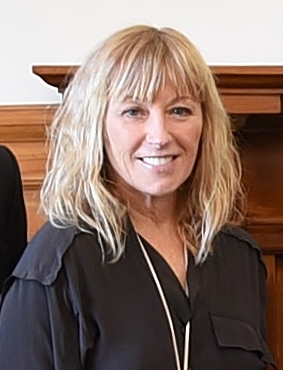
Cindy Sherman is an American feminist artist best known for her photographs. Sherman was born in 1954 in New Jersey. Her famous photography series consists of staged self-portraits called Untitled Film Stills. The series was inspired by the objectification of female characters in Hollywood films from the 1950s and 1960s. Sherman’s works focus on ideas surrounding body image and masquerade.
Feminist Artwork
Notable feminist artwork include “The Dinner Party” by Judy Chicago, “Semiotics of the Kitchen” by Martha Rosler, “Untitled (Your gaze hits the side of my face)” by Barbara Kruger, “Some Living American Women Artists” by Mary Beth Edelson, and “Change: Faith Ringgold’s Over 100 Pound Weight Loss Performance Story Quilt” by Faith Ringgold, among others. More information on these artworks is included below:
1) The Dinner Party by Judy Chicago, 1979, installation, Brooklyn Museum
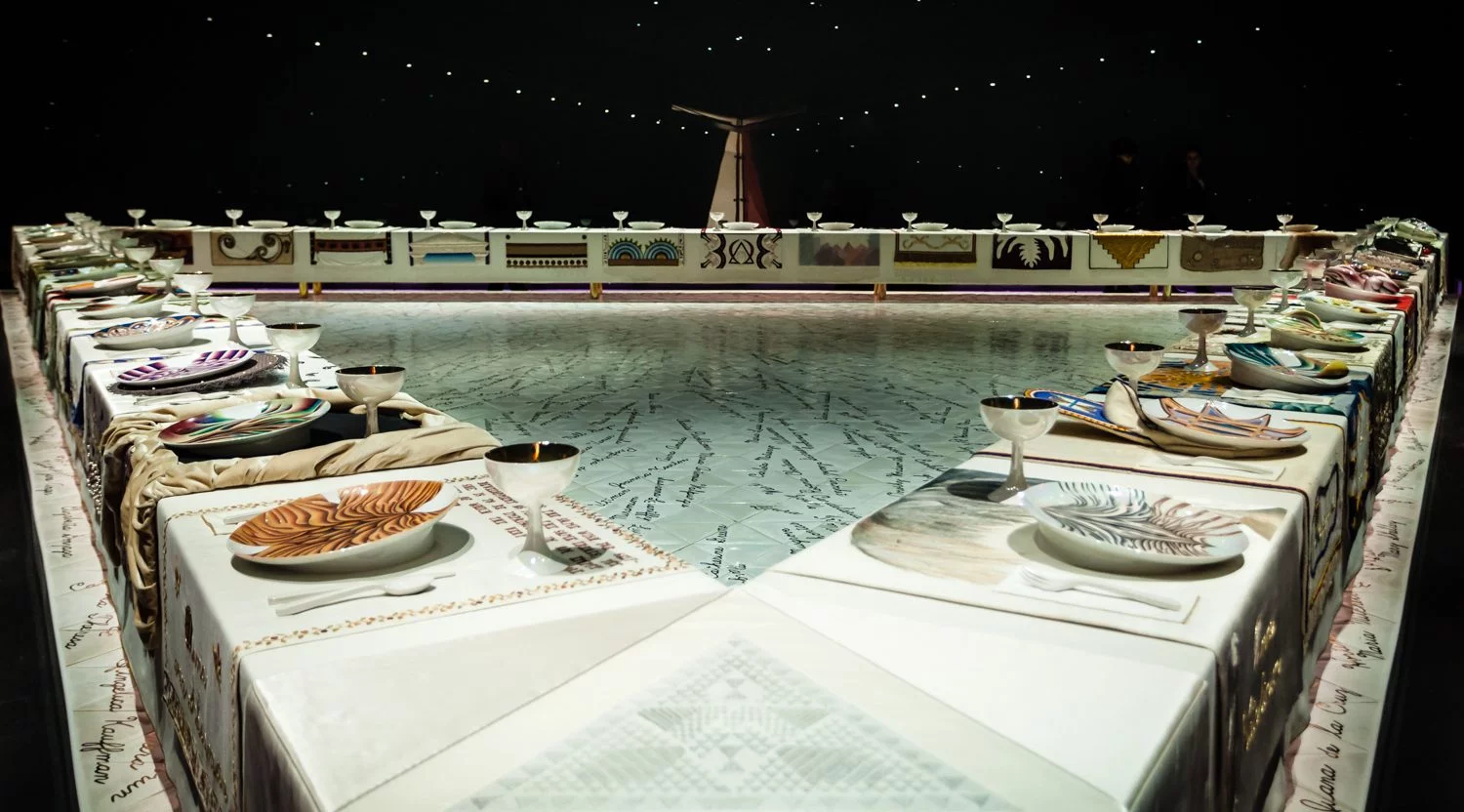
Judy Chicago’s installation called The Dinner Party is one of the emblems of feminist art. Chicago worked on this piece for five years with many volunteers helping her. The installation was first exhibited at the San Francisco Museum of Modern Art in 1979 where a record number of visitors came to see it. The work consists of a triangular table where plates are set for important figures from women’s history. Each plate visually and symbolically represents the women it is dedicated to. Each place setting features embroidered parts of textiles and carefully designed ceramic plates that resemble vulvas. By using needlework and ceramics in her famous piece, Chicago deliberately used art forms that were negatively considered women’s work and crafts. The installation also features a floor filled with porcelain tiles with 999 names of historical women written on them. Chicago’s famous feminist artwork teaches us about forgotten women’s history while presenting us with art forms that were disregarded as feminine. After the premiere of The Dinner Party in 1979, the work was exhibited in a traveling exhibition in the United States and abroad. Feminists, activists, and everyday people interested in seeing the work organized these exhibitions themselves, without the help of major art institutions. The piece is now permanently exhibited at the Elizabeth A. Sackler Center for Feminist Art at the Brooklyn Museum.
2) Semiotics of the Kitchen by Martha Rosler, 1975, video, MoMA
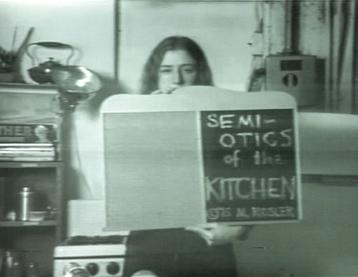
The sphere of the home was also frequently used by feminist artists in order to emphasize the unfair confinement of women. In this 6-minute-long video called Semiotics of the Kitchen, we see Martha Rosler dressed in an apron reciting names of kitchen utensils in a bizarre and theatrical way. Rosler created a feminist parody out of popular cooking shows that were broadcasted during the 1960s. The work is now a part of the MoMA collection.
3) Untitled (Your gaze hits the side of my face) by Barbara Kruger, 1981, silver print
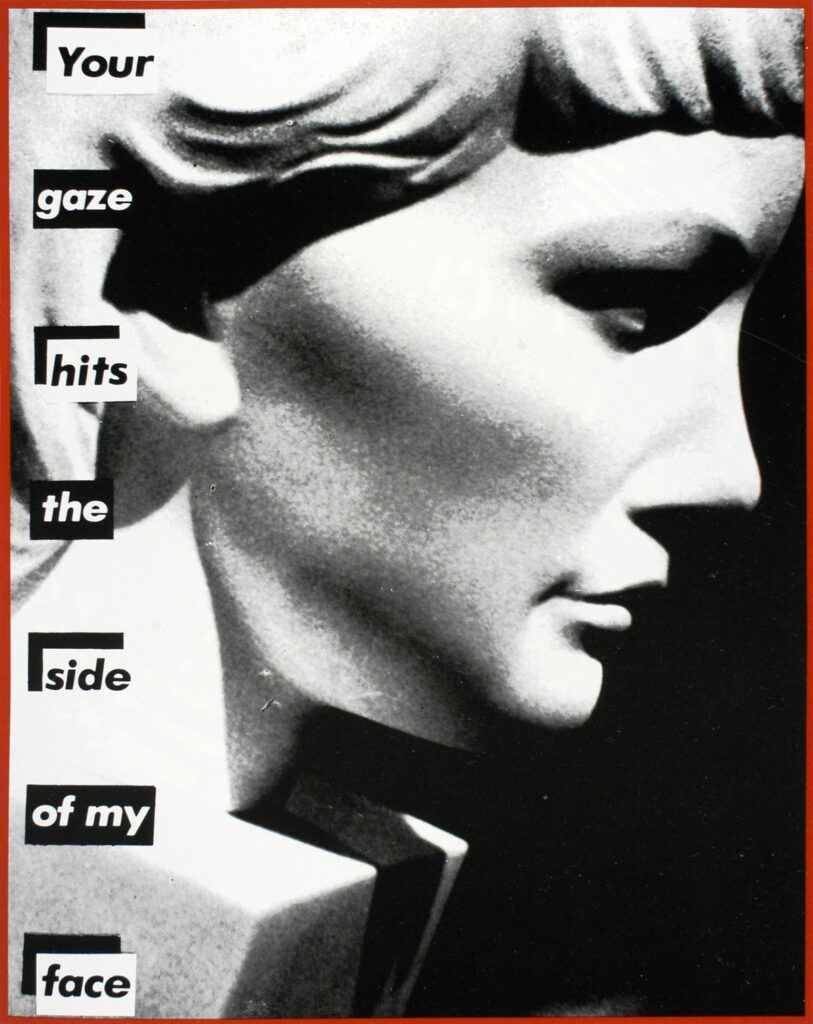
In Barbara Kruger’s work Your gaze hits the side of my face the artist shows us an image of a sculpture while referencing ideas about the male gaze that were dominant in feminist scholarship at the time. The theory about the male gaze and the objectification of women in mass media was popularized through Laura Mulvey’s famous feminist essay called Visual Pleasure and Narrative Cinema written in 1975. With a background in graphic design, Kruger carefully uses text in her works to highlight different political issues. The artist’s pieces often imitate advertising images, however, we don’t see any products being sold to us, so we must focus on the text.
4) Some Living American Women Artists by Mary Beth Edelson, 1972, silver print, MoMA
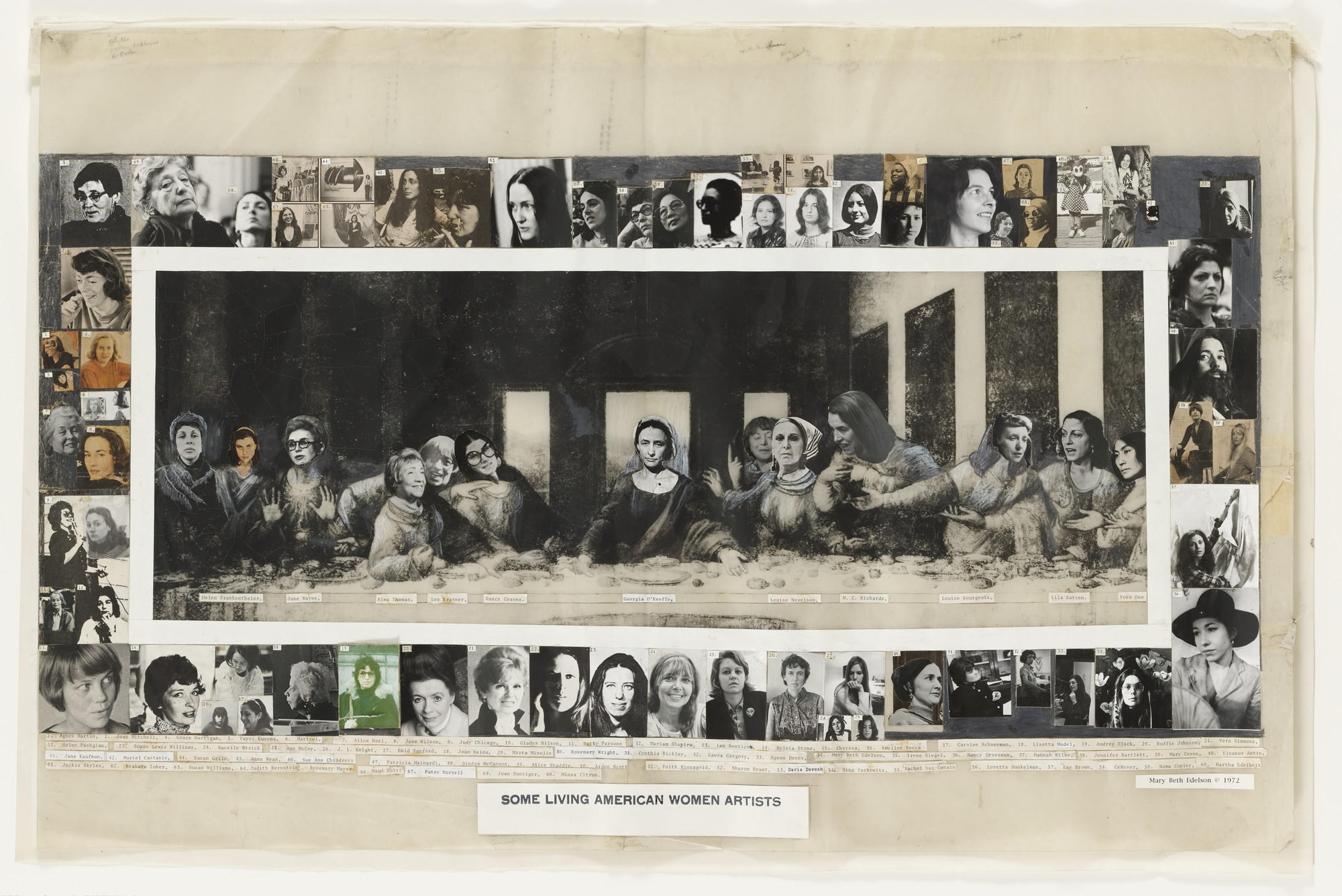
Feminist artist Mary Beth Edelson created her own version of The Last Supper in 1972. The feminist artist swapped the faces of Jesus Christ and the apostles with the faces of women artists like Georgia O’Keeffe, Yoko Ono, and Helen Frankenthaler. Around the main image, we see even more photographs of women artists. Many feminist artworks like this one show women who were excluded from the dominant narratives of art history. The tendencies of feminist artists to change that narrative are obvious here.
5) Change: Faith Ringgold’s Over 100 Pound Weight Loss Performance Story Quilt by Faith Ringgold, 1986, quilt
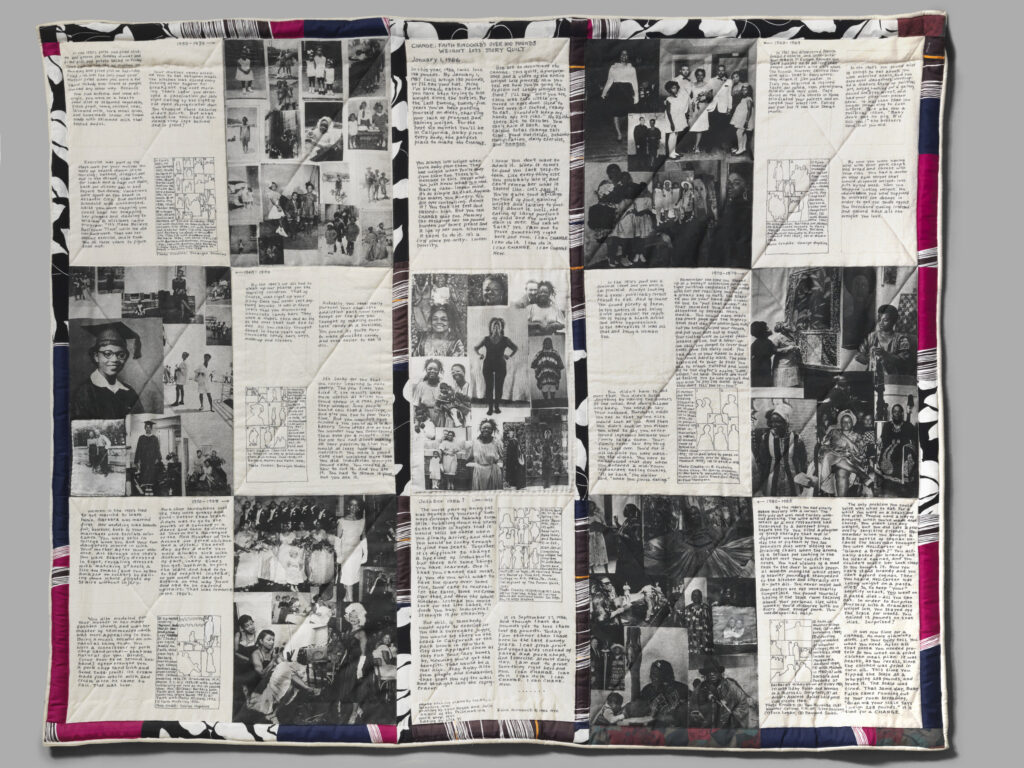
In 1986, Faith Ringgold created a quilt called Change: Faith Ringgold’s Over 100 Pound Weight Loss Performance Story Quilt. The work tells us a story about Ringgold’s eating and dieting habits. The artist touches upon topics concerning body image, beauty ideals, and race. In the piece, Ringgold included her personal photographs along with her written words, making the personal become political.
What Art Movements Influenced Feminist Art?
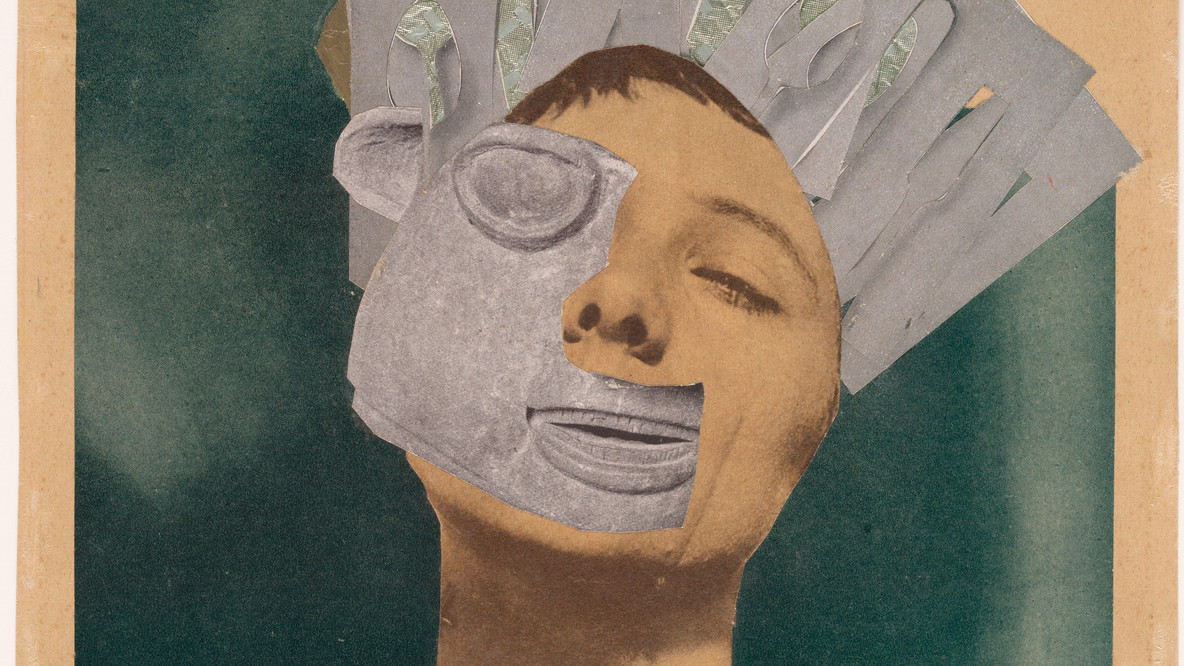
Feminists rejected the notion that art made by men was superior to art made by women artists and moved away from modernist ideals.
Dadaist performances inspired the birth of performance art which was a frequently used medium in feminist art. Dadaism proved to be influential to feminist art in one more way: Photomontages created by the Dada artist Hannah Hoch, especially the ones concerning images of women, truly look like proto-feminist artworks.
Works created by artists like Louise Bourgeois and Frida Kahlo were also inspirational to many female authors of the movement.
What Are Movements did Feminist Art influence?
The influence of feminist art can be seen in works created by some members of the Young British Artists group like Tracey Emin and Sarah Lucas. Feminist art ideals are also present in many contemporary artworks made by a variety of artists all around the world.
But feminist art didn’t just influence artists. The movement had a great impact on art history, art theory, and art institutions. The movement also influenced the expansion of alternative exhibition spaces.
What Other Art Movements are Related to Feminist Art?
Feminist art flourished during the seventies and the eighties along with other related art movements like performance art and conceptual art. New art mediums like video also had a special place in the feminist art movement. Feminist art is also related to postmodern art.
